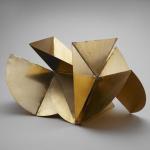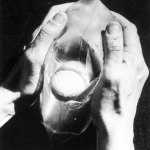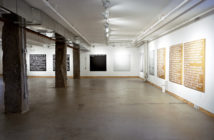Begin by taking a strip of paper, twisting it, and taping the ends together; this forms a mobius strip. To continue, in Clark's own words, you:
. . .take a pair of scissors, stick one point into the surface and cut continuously along the length of the strip. Take care not to converge with the pre-existing cut-- which will cause the band to separate into two pieces. When you have gone the circuit of the strip, it's up to you whether to cut to the left or to the right of the cut you've already made. This idea of choice is capital. The special meaning of this experience is in the act of doing it. The work is your act alone. . .
Daunted by the prospect of punctuating the middle of my mobius strip, I chose to begin on one side, and began cutting inward along the now-infinite plane of my scrap of paper. It resulted in one long string, which pooled at my feet as I cut away, breaking the mobius strip once it was too thin to continue. The repetitive motion of the scissors was hypnotizing, and when I was done I wasn't sure if minutes or hours had passed.
I am indebted to Guy Brett for these first paragraphs, whose own invocation to recreate Clark's work I immediately took to heart: "I might hand you a plastic bag from a kitchen roll, a rubber band, and a pebble. I would show you how to inflate the bag, seal it with the rubber band, press the pebble into one of its corners."1 These are instructions for Pedra e Ar/Air and Stone (1966).
I searched my apartment for the closest equivalents that I could find: a plastic shopping bag, a rubber band saved from take-out. I contemplated searching for a stone, which made me think of the rocks placed on gravestones in Jewish cemeteries, making the stone, for me, become evocative of loss and memory. Instead of a stone, I used a baseball.
Filling the bag with air made me acutely aware of my own breathing. I felt foolish, childlike, as if I were fogging up the window of the school bus so I could scrawl my name on the glass. Holding the inflated bag, pressing gently on it with the stone rising and falling in the middle, is highly tactile, making one aware of their own bodily presence. The contexts and experiences I brought to the work made me continue to think of the stone as a marker of memory, the work as a whole an encounter between permanence and impermanence.
Brett suggests that actions, not words, are best for communicating Lygia Clark’s work. Perhaps words are too institutional for an artist who eschewed institutions, but that is the medium we have. Clark herself did use them, after all, in manifestos and texts such as the one quoted here.
Among the languages Lygia Clark employed, the experience of embodiment is a universal language within her work. Her audience didn't need to be wealthy, because her works of art could not be commodified. They did not have to be literate, because her interactive objects communicated complex ideas wordlessly. In much of her work, she used the lowest possible objects, so common that they can be recreated from objects one likely has on hand already. Her work was highly connected to the body; when cutting and cutting away at an infinite shape, your hands begin to ache where they grip the scissors. Balancing a stone on air reminds one of the act of breathing. In Clark's original iteration, she used the plastic bag she had pulled off her own cast on her arm.
As a person immersed in art, either professionally or not, it is easy to forget what it was like being uninitiated. An encounter with a new artist often happens fleetingly, assimilated quickly within a larger body of knowledge. Perhaps I should be embarrassed to admit I hadn't previously encountered Lygia Clark's work, or perhaps it's simply a reflection of the educational and institutional resources to which I have had access. I was still in grade school when Lygia Clark was included in the landmark exhibition 'Inside the Visible,' which was on view at the Institute of Contemporary Art in Boston in 1996.
This is an autobiography of the discovery of an artist. I recently found Clark's name buried in a scrawl of lecture notes from college, though her name didn't stick in my memory at the time; a detail sacrificed thanks to pragmatic study skills, one that never appeared on an exam. The nature of Clark's work lent itself well to a meditation on what it means to encounter an artist for the first time. For me, this original encounter only really occurred a few months ago. It was a discovery that unfolded slowly, as I sat with my reconstructions of her work and later methodically searched for exhibition catalogs that included her.
At first encounter, for me, her work both felt like a revelation and made me ashamed: how could I come so belatedly to something that I recognized as significant? But more importantly, who am I to feel that I am discovering something new? To engage in this process of discovery when clearly so many people have encountered, and written about, her work before me? I was not, by far, the first person to discover Lygia Clark. So my experience of discovery was dampened by the knowledge that it meant something, this gap in my knowledge that was being filled, both in terms of what had been deemed important enough to be taught to me and in what I deemed important enough to commit to memory.
Lygia Clark is not exactly unknown internationally. She lived and worked in Paris for many years, where she engaged in participatory artwork with a gang of students at the Sorbonne. Here she conducted her Baba Antropofagica (Cannibalistic Drool), performance-like events that were not performances, because everyone was a participant (in Clark's words: "There is no spectator here"), and even the causal participant was shunned. As one participant recalled:
. . .anonymous mouths are holding cotton-reels inside them, from which the thread, coated with saliva, is being noisily pulled by equally anonymous hands and allowed to drop on my body. . .I gradually lose my fear of seeing my body-image, myself, dissolve: I begin to be that slobber-tangle.2
Though we were not participants, we are able to access these events photographs. Does this make us spectators? Is there any way to engage these works, so many years later, without our entry point being through the process of looking? But these photographs exist, so we must have Clark's blessing.
Looking at the images that remain of these actions, I wondered what thread might feel like in one's mouth. They brought to mind learning how to thread a needle as a child, wetting the end with my tongue to get the thread through the eye. I found a spool of thread, but not one small enough to fit in my mouth, so I began to pull the thread into my mouth with my teeth. The act felt more subversive than I expected; after the initial novelty fell off, it was hard to continue. I thought the thread would have more weight to it, but it just sat limply on my tongue, like a net. Eventually, I began to pull the string out of my mouth, slowly, allowing it fall into my lap. The act felt so absurd that I couldn't imagine doing it in front of other people, though it’s possible the camaraderie of a group would have lessened my self-consciousness. Lygia Clark described these actions as "rites without myths," and I understand what she means now: The entire process felt like a write of initiation. Perhaps it was something meant to be a kept secret—it is more difficult to write about than I expected.
There are other works of Clark's that I can't engage with, and which I don't have the opportunity to see in person at the moment. Still, immersing myself in some of her work has helped me understand those that I can only access through images. I understand better how the mobius strip winds through space (Trepantes/Grubs, 1964), challenging our conceptualization of interior and exterior. I can better imagine how it might feel to modify and transform one of her beasts (Bichos) after having held air and stone in my hands. The beasts, too, like the grubs and the trailing I created, have no reverse side—a unifying aspect of Clark's work that I have now engaged with directly. I try recreating one with origami paper, folding and re-folding to understand the infinite mutability. Here, sadly, I feel my imitation falls short.
Some of her work I didn't access through a photograph but through a written description. In these instances I began, not as a spectator, but a participant; as I read the words and imagined the work they described, my imagination allowed transmuted Clark's original, like a message in a game of telephone. Clark wrote of her own work that some "did not lend themselves to any direct presentation, but at least they could be described." And of course she wrote manifestos including instructions—mandates, almost—for recreating her objects and actions.
I've had many experiences with artworks that I remember vividly and can recall in detail; my emotions, the environment, the disorienting feeling of losing track of time completely. With few exceptions, these encounters have taken place within the bounds of the museum. So recreating and re-preforming works of art in solitude, within my own familiar surroundings and outside the institution, is a novel, somewhat unsettling, experience for me.
The challenge of collecting and preserving artwork, of which there is no 'original,' is neither unique to Clark's work nor a novel challenge to museums (Sol LeWitt's wall drawings come to mind). Neither is the challenge of engaging the museum’s visitor nor is the discussion regarding participation within the museum. But my encounter with Clark made me reconsider my own role as spectator and participant, both in relation to artwork and within the museum space.
Near the end of Clark's life, she allowed her work to be shown in a museum exhibition. In Rio de Janeiro and later in Sao Paulo, audiences were able to both see and to interact with her work, as well as make their own models of her interactive objects. Subsequent exhibitions of her work have included replicas that visitors can handle and with which they can interact. Making these modifications to the type of traditional institutional space that Clark dreaded might be a small step towards changing an institutional space from within it. Today, Clark’s challenge to museums seems prescient, given the rise of participation via social media and new technology, so rapidly embraced by museum institutions.
Clark's artistic career, particularly in regards to the medium she engaged, evolved over time, though the motivations and purpose behind it remained quite consistent. Her work culminated, at the end of her career, in working with patients in a therapeutic setting, allowing engagement with her artistic practices to become a kind of therapy. In that spirit I found myself meditating on her work as I encountered and recreated it, with an innocence that often feels impossible after one has immersed one’s self in the study of art history. These meditations lead me back again to contemplating the possibilities of the participatory museum: how institutional spaces might be an entry point for not only looking at art, but also for living with it.
- lygia Clark, Baba Antropofágica (Cannibalistic Drool), 1973
- Lygia Clark, Baba Antropofágica (Cannibalistic Drool), 1973
- Lygia Clark, Pedra e Ar (Air and Stone), 1966
- Lygia Clark, Caminhando (Going/Trailing), 1964
[1] Guy Brett, Carnival of Perception (London: Institute of International Visual Arts, 2004): 27.
[2] M Catherine de Zegher, Inside the Visible (Boston: Institute of Contemporary Arts, 1996): 423







